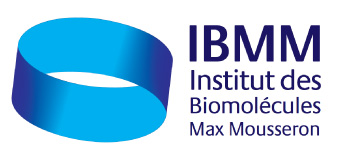PhD proposal – ANALYTIC SCIENCES of BIOMOLECULES team
THERAPEUTIC PEPTIDES AND THE CONTROL OF THEIR CHIRALITY : MAJOR CHALLENGE IN ANALYTICAL SCIENCES
This thesis is part of a large-scale research project aiming at probing the chirality of therapeutic peptides. This project is bringing together the vast majority of the IBMM analytical team (5 teacher-researchers, 3 technical staff). Preliminary work was carried out as part of two master 2 internships and a thesis which is coming to the end of its first year. The recruited person will join this research consortium. Due to different biological properties, controlling the chirality of drugs is a central issue in the pharmaceutical industry. For therapeutic peptides (i.e. 7% of drugs marketed from 2015 to 2019), the epimerization of an L series amino acid into its D form represents a major difficulty when controlling synthetic impurities or degradation compounds generated post-administration. Thus, any impurity which would come from an alteration of a stereogenic center must be detected at trace level, which constitutes a major difficulty to overcome requiring stereoselective analytical methods. Indeed, verifying the homochirality of synthetic peptides consisting of numerous residues involves the efficient separation of diastereoisomers at a very low level of contamination (<0.1%), which refers to an important analytical challenge in the development of a drug. Although much effort has been devoted to separations of diastereisomers by liquid chromatography (LC) and capillary electrophoresis (CE) on the one hand, and more difficultly by mass spectrometry (MS) on the other hand, such approaches, quite rarely applied to peptides, have failed to provide the required sensitivity. This thesis subject therefore aims to develop very robust analytical methods capable of detecting and quantifying an epimerized residue (% of D form) whatever the peptide considered. Among the amino acids which, within a peptide, that are subject to this optical conversion, we particularly targeted histidine (His) and aspartic acid (Asp). While histidine presents a side chain which implies increased reactivity compared to other residues with respect to racemization during solid phase synthesis protocols, aspartic acid is not stable in vivo and can evolve under the action of L-to-D isomerase. The challenge is therefore twofold: to implement analytical methodologies which will make it possible to verify the optical integrity of therapeutic peptides containing one or more histidine residues to satisfy the regulations of the European Pharmacopoeia and also to control the optical stability of therapeutic peptides containing aspartic acid after administration to establish the degradation profile. Thus, the recruited doctoral student will work within the Analytical Sciences team of the Max Mousseron Institute of Biomolecules. Drawing on the team’s expertise in mass spectrometry and separation techniques for the analysis of synthetic peptides, an integrative approach will be proposed for the detection and quantification of epimerization traces of various peptide sequences. It will combine chiral LC/CE separation methods coupled with tandem mass spectrometry (MS/MS), and ion mobility (IM) experiments. The required instrumental equipment is available in the team (LC, EC) and at the LMP platform (LC/MS/MS couplings). Tripeptides containing His or Asp residues will serve as models to establish analytical methods in order to deploy and optimize them on therapeutic peptides of interest selected for proof of concept. The team has a collection of peptides that can be studied for method development. In addition, the IBMM’s SynBio 3 platform may be used to prepare peptides which would be necessary for analytical studies depending on the progress of the thesis and the progress obtained.
1. D.J. Triggle, Stereoselectivity of drug action, Drug Discovery Today, 1997, 2, 138 doi: 10.1016/S1359-6446(97)01010-6. 2. B.G. de la Torre et al., Peptide Therapeutics 2.0, Molecules 2021, 26, 627 doi:10.3390/ molecules26030627. 3. P.S. Bansal et al., Substrate Specificity of Platypus Venom L-to-D-Peptide Isomerase, J Biol Chem 2008, 283, 8969doi:10.1074/ jbc.M70976 2200. 4. A. Tarafder et al., Chiral chromatography method screening strategies: Past, present & future, J Chromatog A, 2021, 461878doi:10.1016/j.chroma.2021.461878. 5. S. Bernardo-Bermejo et al., Chiral capillary electrophoresis, TrAC, 2020, 124, 115807 doi:10.1016/j.trac.2020.115807. 6. D. Han et al., Chiral mass spectrometry: An overview, TrAC, 2020, 123, 115763 doi:10.1016/j.trac.2019.115763.
